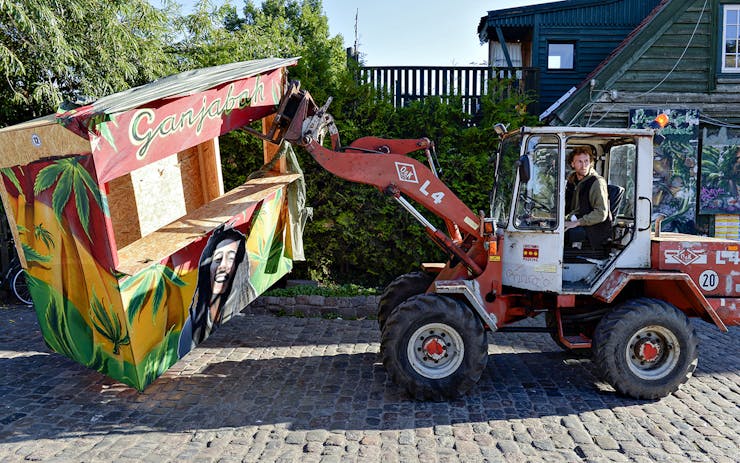For decades it was the local police who sporadically tore down the hashish stalls in Denmark’s world-famous Freetown Christiania. But after last month’s fatal shooting on the neighborhood’s Pusher Street, it was the inhabitants themselves who demolished the open-air cannabis market.
On Aug. 31, a shooter wounded two police officers and a bystander, then fled the scene. He was later injured injured in a shootout with police outside the Copenhagen. He died at a university hospital.

Danish police officer on patrol near Christiania in Copenhagen, Denmark, late night Wednesday, Aug. 31, 2016. Police shot and fatally wounded an armed Danish man following an earlier Copenhagen shootout that left two officers and a bystander wounded. (Jens Dresling/Photo via AP)
Initial reports linked the suspect to the Islamic State terrorist network, but those have since been denied. Police suspect the attack was drug-related, as the shots began during a routine police check of Pusher Street.
Shortly after the incident, Christiania’s residents themselves started to dismantle their so-called Hash Alley for the first time in its existence.
“If you support Christiania, stop buying your cannabis here.”
When the former hippie community began tolerating the sale of hashish more than 40 years ago, it was the residents themselves who did the selling. But in recent years, the business has become independent from the bohemian neighborhood and its ideals. Outside cannabis dealers now profit from the tolerance of Christiania residents, while at the same time inviting further crackdowns by police.
“Let’s be clear: Christiania is still for the legalization of cannabis,” Risenga Manghezi, a spokesman for the self-proclaimed autonomous community, told reporters. “But as the situation is now, with ever-increasing violence, we do not want it here anymore.”
In a press release, residents told the Danish cannabis community it’s time to start shopping elsewhere.
“Christiania cannot take responsibility for housing all of Denmark’s cannabis trade,” they wrote. “We can remove the stalls but we can’t ensure that they don’t come back. We need all of Denmark’s help for that. “If you support Christiania, stop buying your cannabis here.”
Drug policy in Denmark at the federal level is currently directed by a very conservative government that for the most part ignores words like legalization and decriminalization. But Copenhagen Mayor Frank Jensen has long called for Dutch-style coffeeshops where cannabis can be sold under strict conditions. But as in almost all other EU countries, such advances require the approval of the federal government.
“We’re thinking of about 30 to 40 outlets where the staff is not concerned with selling more [product], but with advising consumers,” Copenhagen Health Councilor Mikkel Warming said in 2011. A sizeable majority of City Council members adopted a coffeeshop initiative at the time and sent it to the Danish Parliament. There was even a cannabis coffeeshop, “Smokenhagen,” that operated openly in those days. But it didn’t last long; the shop was raided by police in January 2013 and has since reopened as a legal cannabis seed bank.
Governments in Denmark, whether led by conservatives or social democrats, have roundly rejected past legalization attempts. Former Prime Minister Helle Thorne-Schmidt supported legalization as a member of the European Parliament, but as head of the national government she reversed course and rejected Copenhagen’s coffeeshop model in 2013. Christiana is now paying the price of that failed federal effort.
Since the change of government in 2015, the crackdown has intensified, even as other European countries relax restrictions on cannabis. Even before the shooting, that added to the tension in Christiania. But the decision by residents to abandon the open-air cannabis market could change that relationship.
Via Twitter, Prime Minister Lars Løkke Rasmussen congratulated Christiania’s inhabitants on the decision to tear down Pusher Street. It was a bold and courageous move. But now only an equally courageous step by the Danish government can calm the situation, to the benefit of all. The loss of Pusher Street doesn’t mean cannabis will leave Copenhagen; the city needs coffeeshops more urgently than ever. Residents and most local politicians have long understood this. Now the ball’s in the government’s court.





